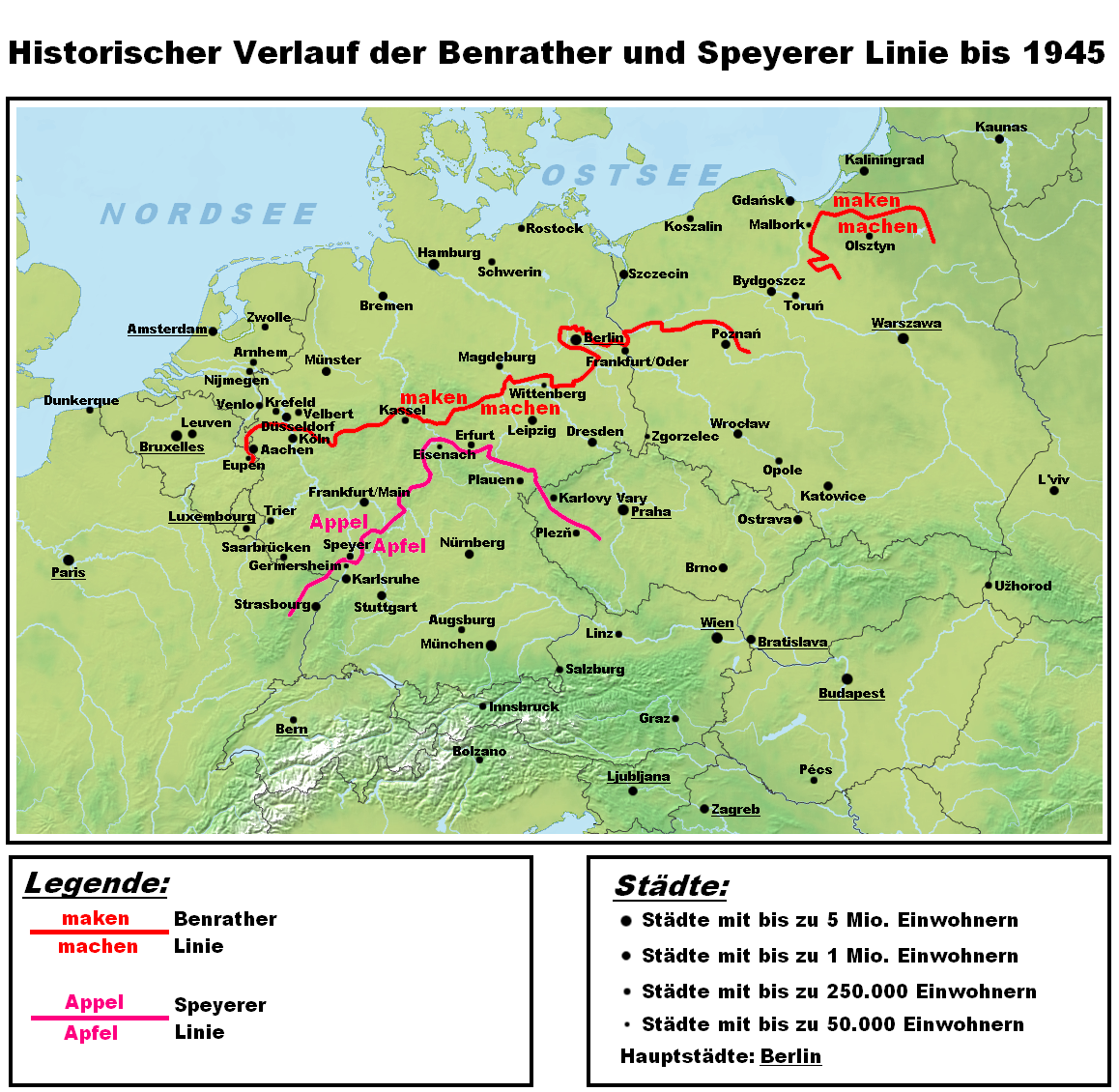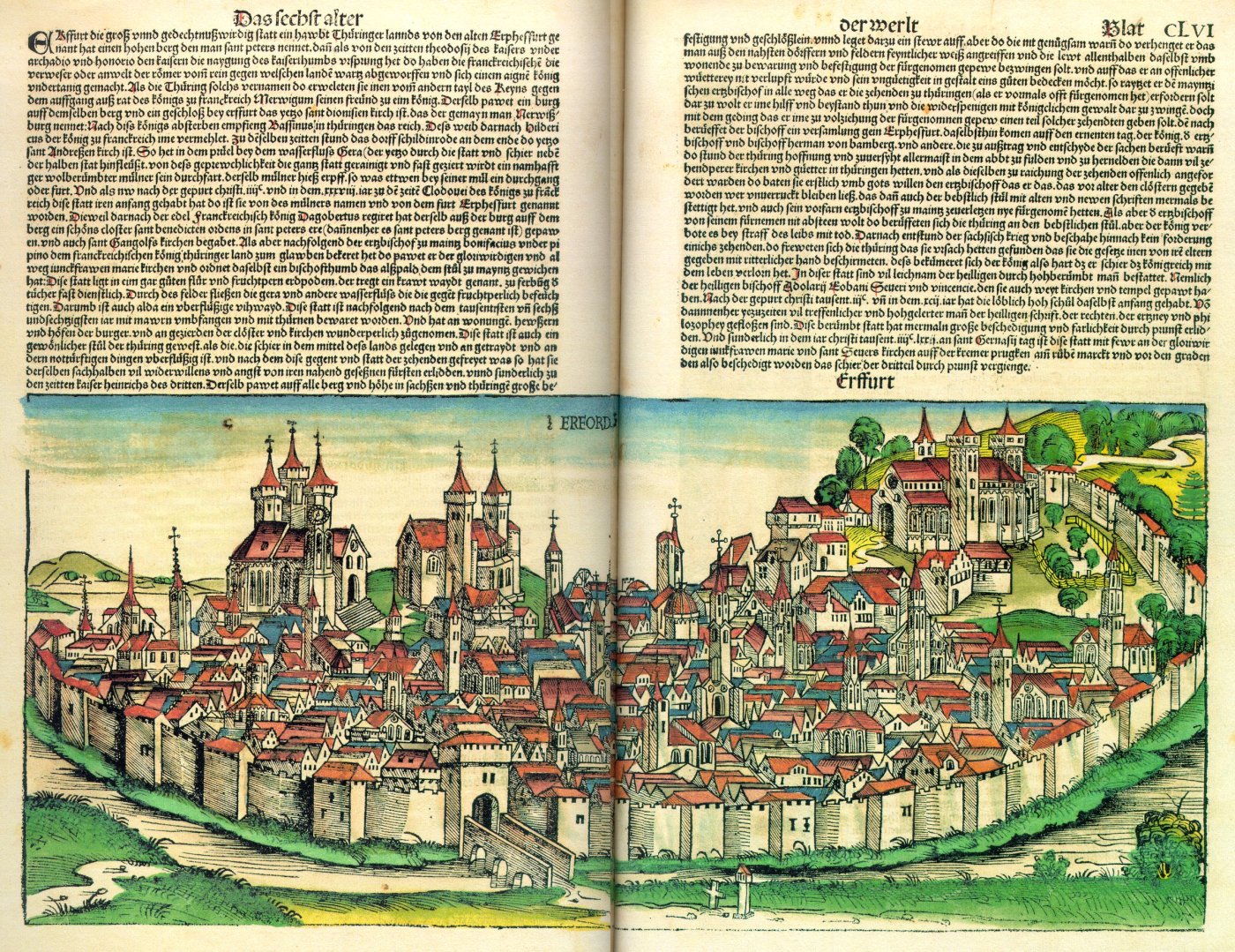|
Speyer Line
In German dialectology, the Speyer line or Main line ( Main River) is an isogloss separating the Central German dialects to the north, which have a stop in words like ''Appel'' "apple", from the Upper German dialects to the south, which have an affricate, ''Apfel''. The Speyer line begins in Alsace near Strasbourg, and runs northeast to Thüringen, crossing the Rhine at Speyer. After passing close to Erfurt, it turns southeast and continues into the formerly German-speaking parts of Bohemia. The line is exemplified by place names containing an uncombined /p/ phoneme, which are located north of the line and include Paderborn, Potsdam, and Wuppertal. Those with an affricate /pf/, including Pfaffenhofen and Pforzheim, lie mostly to the south. See also * Benrath line * High German consonant shift * Sankt Goar line * Uerdingen line The Uerdingen Line (, ; named after Uerdingen by Georg Wenker) is the isogloss within West Germanic languages that separates dialects which prese ... [...More Info...] [...Related Items...] OR: [Wikipedia] [Google] [Baidu] |
Erfurt
Erfurt () is the capital (political), capital and largest city of the Central Germany (cultural area), Central German state of Thuringia, with a population of around 216,000. It lies in the wide valley of the Gera (river), River Gera, in the southern part of the Thuringian Basin, north of the Thuringian Forest, and in the middle of a line of the six largest Thuringian cities ('':de:Thüringer Städtekette, Thüringer Städtekette''), stretching from Eisenach in the west, via Gotha, Erfurt, Weimar and Jena, to Gera in the east. Together with Kassel and Göttingen, it is one of the cities with more than 100,000 inhabitants lying closest to the geographic centre of Germany. Erfurt is south-west of Leipzig, north-east of Frankfurt, south-west of Berlin and north of Munich. Erfurt's old town is one of the best preserved medieval city centres in Germany. The Gera (river), Gera is spanned by the Krämerbrücke, Merchants' Bridge (''Krämerbrücke''), one of the rare bridges with ho ... [...More Info...] [...Related Items...] OR: [Wikipedia] [Google] [Baidu] |
Sankt Goar Line
In German linguistics, the Sankt Goar line, line, or line is an isogloss separating the dialects to the north, which have a ''t'' in the words (English ''that'') and (English ''what''), from the dialects to the south (including standard German), which have an ''s'': . The line runs from North-East to South-West and crosses the river Rhine at the town of Sankt Goar. See also * High German consonant shift * Rhenish fan The subdivision of West Central German into a series of dialects, according to the differing extent of the High German consonant shift, is particularly pronounced. It is known as the Rhenish fan (, ) because on the map of dialect boundaries, the li ... References Isoglosses {{historical-linguistics-stub ... [...More Info...] [...Related Items...] OR: [Wikipedia] [Google] [Baidu] |
High German Consonant Shift
In historical linguistics, the High German consonant shift or second Germanic consonant shift is a phonological development (sound change) that took place in the southern parts of the West Germanic languages, West Germanic dialect continuum. The shift is used to distinguish High German from other continental West Germanic languages, namely Low Franconian (including standard Dutch language, Dutch) and Low German, which experienced no shift. The shift resulted in the affrication or spirantization of the West Germanic voiceless stop consonants /t/, /p/, and /k/, depending on position in a word. A related change, the devoicing of the voiced stopped consonants /d/, /b/ and /g/, was less widespread, with only the devoicing of /d/ being found in most dialects. There is no consensus on when the High German consonant shift occurred; it probably began between the 3rd and 5th centuries and was complete before the first written examples in Old High German, the earliest recorded stage of High ... [...More Info...] [...Related Items...] OR: [Wikipedia] [Google] [Baidu] |
Benrath Line
In German linguistics, the Benrath line () is the isogloss: dialects north of the line have the original in (to make), while those to the south have the innovative (). The line runs from Aachen in the west via Benrath (south of Düsseldorf) to eastern Germany near Frankfurt an der Oder in the area of Berlin and Dessau and through former East Prussia dividing Low Prussian dialect and High Prussian dialect. It is called Benrath line because Benrath is the place where it crosses the Rhine. The High German consonant shift (3rd to 9th centuries AD), in which the (northern) Low German dialects for the most part did not participate, affected the southern varieties of the West Germanic dialect continuum. This shift is traditionally seen to distinguish the High German varieties from the other West Germanic languages The West Germanic languages constitute the largest of the three branches of the Germanic languages, Germanic family of languages (the others being the North German ... [...More Info...] [...Related Items...] OR: [Wikipedia] [Google] [Baidu] |
Pforzheim
Pforzheim () is a List of cities and towns in Germany, city of over 125,000 inhabitants in the federal state of Baden-Württemberg, in the southwest of Germany. It is known for its jewelry and watch-making industry, and as such has gained the nickname "Goldstadt" ("Golden City"). With an area of , it is situated about halfway between the cities of Stuttgart and Karlsruhe at the confluence of three rivers (Enz, Nagold (river), Nagold and Würm (Nagold), Würm). It marks the frontier between Baden and Württemberg, being located on Baden territory. From 1535 to 1565, it was the home to the Margraviate of Baden-Durlach, Margraves of Baden-Durlach. The City of Pforzheim is a ''Districts of Germany, Stadtkreis'', meaning it is both a Municipalities of Germany, municipality and a Districts of Germany, district at the same time. Also, it hosts the administrative offices of the Enz (district), Enz district that surrounds the city. During World War II, Pforzheim was bombed by the Allie ... [...More Info...] [...Related Items...] OR: [Wikipedia] [Google] [Baidu] |
Pfaffenhofen An Der Ilm
Pfaffenhofen an der Ilm (, ; Central Bavarian: ''Pfahofa an da Uim'') is a municipality in Bavaria, Germany, capital of the district Pfaffenhofen. It is located on the river Ilm, and had a population of 23,282 in 2004. As of a press release in October 2011 from the UN-backed annual International Awards for Liveable Communities (LivCom), Pfaffenhofen an der Ilm was saluted by judges for the quality of its environmental best practice. The Bavarian town of 23,000 people was also named the most liveable city with a population between 20,000-75,000. The elite group of cities fulfilled the awards’ range of key criteria involving environmental best practice, healthy lifestyle of citizens, community involvement as well as arts and cultural heritage. History Evidence of Bronze Age settlements have been found in Pfaffenhofen, with burial mounds found in forest areas north of the town. Historians believe that monks from Ilmmünster Abbey built the Pfaffenhöfe near Altenstadt in the ... [...More Info...] [...Related Items...] OR: [Wikipedia] [Google] [Baidu] |
Wuppertal
Wuppertal (; ) is a city in North Rhine-Westphalia, in western Germany, with a population of 355,000. Wuppertal is the seventh-largest city in North Rhine-Westphalia and List of cities in Germany by population, 17th-largest in Germany. It was founded in 1929 by the merger of Elberfeld, Barmen, Ronsdorf, Cronenberg, Wuppertal, Cronenberg and Vohwinkel Schwebebahn, Vohwinkel, and was initially called "Barmen-Elberfeld" before adopting its present name in 1930. It is the capital and largest city of the Bergisches Land. The city straddles the densely populated banks of the River Wupper, a tributary of the Rhine. Wuppertal is located between the Ruhr (Essen) to the north, Düsseldorf to the west, and Cologne to the southwest, and over time has grown together with Solingen, Remscheid and Hagen. The stretching of the city in a long band along the narrow Wupper Valley leads to a spatial impression of Wuppertal being larger than it actually is. The city is known for its steep slope ... [...More Info...] [...Related Items...] OR: [Wikipedia] [Google] [Baidu] |
Potsdam
Potsdam () is the capital and largest city of the Germany, German States of Germany, state of Brandenburg. It is part of the Berlin/Brandenburg Metropolitan Region. Potsdam sits on the Havel, River Havel, a tributary of the Elbe, downstream of Berlin, and lies embedded in a hilly morainic landscape dotted with many lakes, around 20 of which are located within Potsdam's city limits. It lies some southwest of Berlin's city centre. The name of the city and of many of its boroughs are of Slavic languages, Slavic origin. Potsdam was a residence of the Prussian kings and the German Emperor until 1918. Its planning embodied ideas of the Age of Enlightenment: through a careful balance of architecture and landscape, Potsdam was intended as "a picturesque, pastoral dream" which would remind its residents of their relationship with nature and reason. The city, which is over 1,000 years old, is widely known for its palaces, its lakes, and its overall historical and cultural significance. ... [...More Info...] [...Related Items...] OR: [Wikipedia] [Google] [Baidu] |
Paderborn
Paderborn (; Westphalian language, Westphalian: ''Patterbuorn'', also ''Paterboärn'') is a city in eastern North Rhine-Westphalia, Germany, capital of the Paderborn (district), Paderborn district. The name of the city derives from the river Pader (river), Pader and ''Born'', an old German term for the source of a river. The river Pader originates in more than 200 springs near Paderborn Cathedral, where St. Liborius is buried. History Paderborn was founded as a bishopric by Charlemagne in 795, although its official history began in 777 when Charlemagne built a castle near the Paderborn springs.Ed. Heribert Zelder, Tourist Information Services, ''Welcome to Paderborn'', Stadt Paderborn: Paderborn, Germany, 2009. In 799 Pope Leo III fled his enemies in Rome and reached Paderborn, where he met Charlemagne, and stayed there for three months. It was during this time that it was decided that Charlemagne would be crowned emperor. Charlemagne reinstated Leo in Rome in 800 and was crow ... [...More Info...] [...Related Items...] OR: [Wikipedia] [Google] [Baidu] |
Bohemia
Bohemia ( ; ; ) is the westernmost and largest historical region of the Czech Republic. In a narrow, geographic sense, it roughly encompasses the territories of present-day Czechia that fall within the Elbe River's drainage basin, but historically it could also refer to a wider area consisting of the Lands of the Bohemian Crown ruled by the List of Bohemian monarchs, Bohemian kings, including Moravia and Czech Silesia, in which case the smaller region is referred to as Bohemia Proper as a means of distinction. Bohemia became a part of Great Moravia, and then an independent principality, which became a Kingdom of Bohemia, kingdom in the Holy Roman Empire. This subsequently became a part of the Habsburg monarchy and the Austrian Empire. After World War I and the establishment of an History of Czechoslovakia (1918–1938), independent Czechoslovak state, the whole of Bohemia became a part of Czechoslovakia, defying claims of the German-speaking inhabitants that regions with German ... [...More Info...] [...Related Items...] OR: [Wikipedia] [Google] [Baidu] |
German Language
German (, ) is a West Germanic language in the Indo-European language family, mainly spoken in Western Europe, Western and Central Europe. It is the majority and Official language, official (or co-official) language in Germany, Austria, Switzerland, and Liechtenstein. It is also an official language of Luxembourg, German-speaking Community of Belgium, Belgium and the Italian autonomous province of South Tyrol, as well as a recognized national language in Namibia. There are also notable German-speaking communities in other parts of Europe, including: Poland (Upper Silesia), the Czech Republic (North Bohemia), Denmark (South Jutland County, North Schleswig), Slovakia (Krahule), Germans of Romania, Romania, Hungary (Sopron), and France (European Collectivity of Alsace, Alsace). Overseas, sizeable communities of German-speakers are found in the Americas. German is one of the global language system, major languages of the world, with nearly 80 million native speakers and over 130 mi ... [...More Info...] [...Related Items...] OR: [Wikipedia] [Google] [Baidu] |






